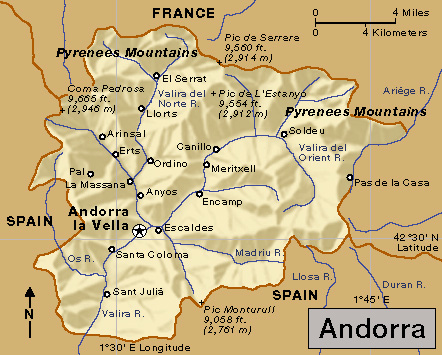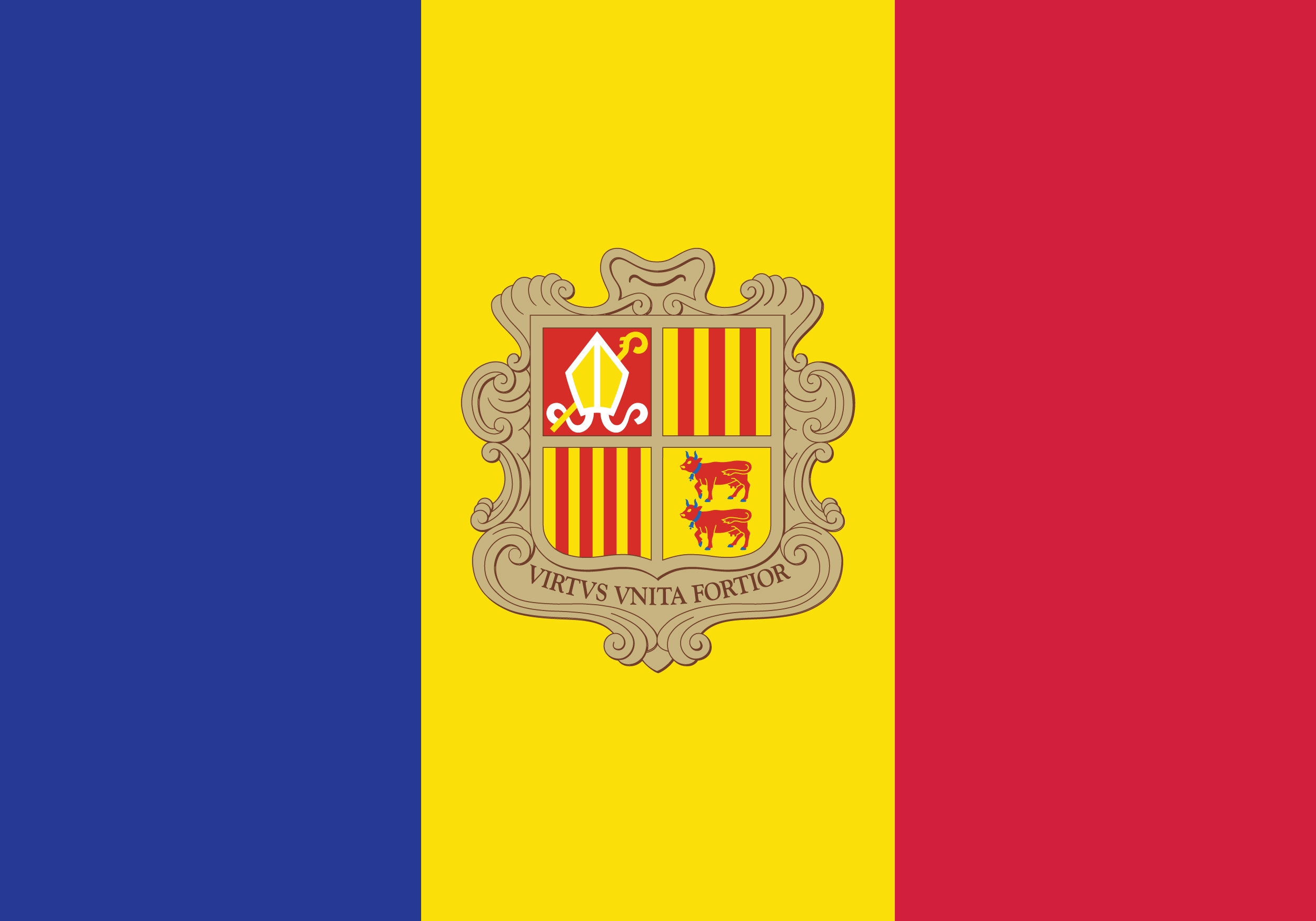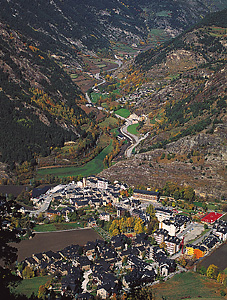Andorra, one of the smallest countries in the world, lies high in the Pyrenees mountains between France and Spain. The official name of Andorra in Catalan, a language that closely resembles the Provençal spoken in southern France, is Valls d’Andorra (Valleys of Andorra). Andorra la Vella (Andorra the Old) is the capital.

Many tourists visit Andorra. They enjoy the rugged beauty of the mountains, the old churches, and the quaintness of the country. In addition, large numbers of people go to Andorra to purchase goods that are relatively inexpensive because Andorra charges almost no tax on them.
The steep, rocky mountains that surround Andorra cut the country off from the rest of the world for hundreds of years. As a result, Andorra’s boundaries have changed little since the Middle Ages. Andorra’s legal system is based on ancient laws and common law (rules based on customs) that date from the Roman Empire.
Government.
Andorra is a parliamentary coprincipality. Until 1993, the bishop of Urgel, Spain, and the president of France ruled Andorra jointly under treaties signed in the 1200’s. Both rulers, known as the “princes of Andorra,” had to agree before any changes could be made in Andorra’s government. Each prince had the right to veto laws made by the parliament.

Andorra's national anthem
In 1993, the citizens of Andorra adopted their first constitution. The Constitution made elected officials responsible for governing Andorra. The role of the princes became mostly ceremonial. But the princes still must approve international treaties with France and Spain, and some other matters concerning boundaries, defense, and internal security.
A 28-member parliament known as the General Council of the Valleys makes the nation’s laws. Two members are elected from each of Andorra’s seven parishes (districts), and the other 14 members are elected nationwide. The General Council elects a head of government from among its members. The head of government then appoints a cabinet, the Executive Council, to help administer the government.
Because Andorra had two rulers for hundreds of years, it often has two sets of public services. For example, it has two postal systems—one French and one Spanish. Both the French franc and the Spanish peseta served as legal tender (lawful money) until 2002, when they were replaced by the euro, Europe’s common currency.
People.
From the 1100’s to the 1930’s, life in Andorra changed little. The people worked as farmers and shepherds. The villages and parishes owned the grazing lands, and farmers owned their own cropland. To keep the cropland from being divided into tiny plots, farmers gave at least three-fourths of their inheritance to one of their children, usually the oldest son. Many of the other children had to move out of Andorra. As a result, more people of Andorran descent now live in France and Spain than in Andorra.
The opening of roads to France and Spain in the 1930’s and the sudden growth of tourism in the 1950’s changed some of the old ways of living. Many who had worked as farmers, shepherds, and smugglers became storekeepers and hotel owners. Tourists brought new wealth, and fewer people had to move out of the country. Some people from Spain have moved into Andorra. Today, only about one-third of the country’s people are Andorran citizens. Over half are citizens of Spain. Other inhabitants are mainly from France and Portugal. Citizenship is given to the children of Andorran citizens and to legal residents after 25 years of residency. Dual citizenship is not permitted.
These changes weakened the strong control Andorran fathers had always held over their families. But in other ways life has changed little. Life for the average Andorran still centers around the family. Many Andorrans still live in big farmhouses with stone walls and rough slate roofs. Most of these houses are three stories high with a barn to house livestock or a tool shed on the ground floor, a living room and kitchen on the second floor, and bedrooms opening onto wooden or iron balconies on the third floor. The people speak Catalan, but most Andorrans also understand French and Spanish. The government prints its official documents in Catalan.
Almost all Andorrans are Roman Catholics, and their religion greatly influences their social life. All public records are kept by the church, and only Roman Catholics can get married in Andorra. On their national holiday, September 8, Andorrans make a pilgrimage (journey) to the shrine of Our Lady of Meritxell, patron saint of Andorra.
Children in Andorra must attend school from ages 6 to 16. Andorra has Andorran, French, and Spanish schools.
Land.
Steep mountain peaks as high as 9,665 feet (2,946 meters) above sea level tower over the valleys of Andorra. Fields and meadows lie in the valleys, and oak, pine, and fir trees cover the lower mountain slopes. Only grass grows farther up the mountainsides. The Valira del Norte (Northern Valira) and the Valira del Orient (Eastern Valira) rivers meet near the town of Andorra la Vella to form the Valira River, which flows into Spain. The main roads in Andorra follow the Valira del Norte toward France and the Valira into Spain.
Andorra has a dry, sunny climate. Three or four heavy snows fall each year, and even powerful snowplows cannot keep the mountain road between Andorra and France open all winter. However, in the valleys south of Escaldes the snows melt in a few days. Winter temperatures at Escaldes range between 20 and 30 °F (–7 and –1 °C). In the summer, the valleys are warm during the day and cool at night. Temperatures at Escaldes reach 70 to 80 °F (21 to 27 °C).
Economy.
Tourism is one of Andorra’s chief sources of income. Andorra’s beautiful mountains and ancient buildings are the main attractions. Ski slopes have been opened at Pas de la Casa and Soldeu, where the snow lasts until the end of April. Tourists can buy many goods at low prices in Andorra, because import duties (charges) are low. The banking industry is also important to the country’s economy.

Andorra has a small amount of arable land, and few Andorrans farm. The country must import most of its food. Tobacco is Andorra’s main crop, and cigarettes and cigars are among the country’s leading manufactured products. Other crops include oats, potatoes, rye, and wheat. Farmers also raise cattle and sheep.
History.
According to legends, Charlemagne either founded or freed Andorra. The first known ruler of Andorra was a Spanish noble, the Count of Urgel. He controlled the region in the A.D. 800’s, and then gave it to the diocese of Urgel. In the 1000’s, the bishop of Urgel could not control Andorra by himself, and he asked a Spanish noble, the Lord of Caboet, to defend the region. A French noble, the Count of Foix, inherited the lord’s duties through marriages. The French count and the bishop fought over Andorra. They finally ended their disputes by signing treaties in 1278 and 1288. The treaties made them joint rulers.
Through marriages, the king of France inherited the count’s rights. During the French Revolution, France refused to rule Andorra. But the Andorrans later asked Napoleon I to rule them, and he accepted in 1806. France’s head of state has been a prince of Andorra since then. Today, the French president serves as prince. Until 1993, as the old treaties required, Andorra paid about $2 every other year to the president of France and about $8 to the Spanish bishop. The bishop also got 6 hams, 6 cheeses, and 12 hens every other year.
In the 1800’s, Andorran farmers began raising tobacco. Until the 1900’s, many Andorrans made their living by smuggling tobacco into France and Spain.
Until the 1930’s, only male citizens who were the heads of households could vote in Andorra. In 1933, Andorran youths stormed the General Council and forced it to give all male citizens over 25 years old the right to vote. In 1970, the voting age was reduced to 21 and female citizens won the right to vote. In 1984, a woman was elected to the General Council for the first time. In 1985, the voting age was lowered to 18.
In 1993, the people of Andorra adopted their first constitution. The Constitution strictly limited the role of the princes in the government and placed responsibility for governing Andorra in the hands of an elected parliament and head of government.
See also Andorra la Vella .
